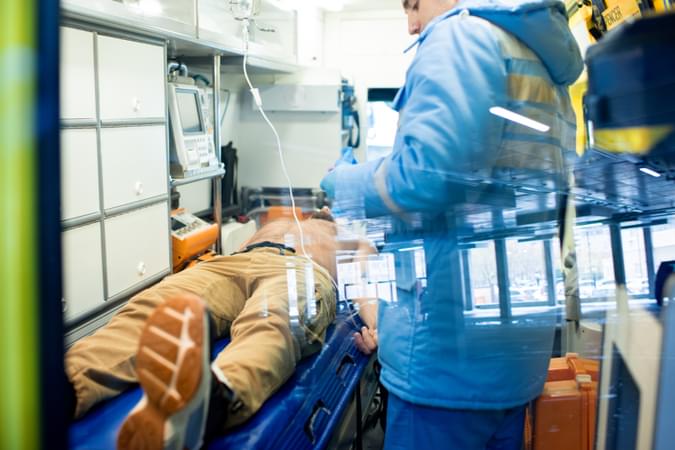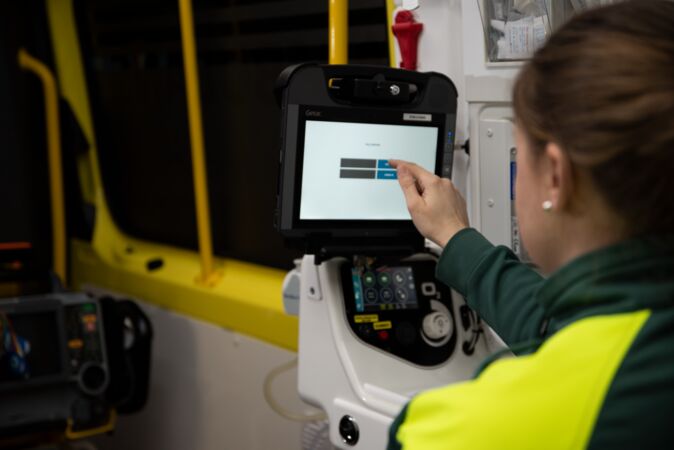Omda’s Paratus and Optima teams have recently completed an innovative pilot that saw them integrate aspects of their respective solutions to benefit the EMS provider in Region Värmland, Sweden. The pilot ensures the customer now has access to advanced historical analytics capabilities by combining the reporting features of Omda Optima with the operational data collected within Omda Paratus.
In May, the pilot concluded successfully and Region Värmland now leverages Optima’s performance analysis capabilities to measure performance and inform decision-making. The region is also exploring the possibility of leveraging the solution’s simulation features in the future.
Establishing a forward-thinking, three-way partnership
Omda Paratus is an innovative mobile solution for rescue vehicles that includes a case handling and routing module for drivers and a patient record and medical support module for paramedics in the rear of the ambulance. Today, the majority of regions in Sweden utilise one or both of the Paratus modules.
Omda Optima includes industry-leading simulation software that enables emergency services to model operational decisions to optimise resource allocation, facilitates data-driven decision-making, and informs long-term strategic planning. It also incorporates historical analysis capabilities.
Historically, the two solutions have been deployed in distinct markets. Omda Paratus is currently oriented towards the Swedish market. On the other hand, Omda Optima counts many organisations around the globe among its customers, including the London Ambulance Service, Hato Hone St John (New Zealand), and British Columbia Ambulance Service.
The Region Värmland pilot exploited the synergies between the Omda solutions, connecting complementary functionalities and helping the customer extract maximum value from their digital resources.
Explaining the trial’s origins
Recognising that Omda Paratus gathers a large, diverse, and insightful range of operational data, the Paratus product team sought ways to better leverage this information.
Experienced with data analysis but lacking the more sophisticated reporting and analysis capabilities available to larger EMS customers, Region Värmland was also seeking ways to improve its analysis of the data its Paratus platform generated.
To complete the picture, the Optima product team had identified elements of its solution that could integrate with Omda Paratus to allow for extensive historical reporting and analysis. It would enable Region Värmland to run a lighter version of the platform that does not include complex simulation features.
Delivering advanced reporting and analysis
Combining the data from Omda Paratus with Omda Optima’s historical analysis features enabled Region Värmland to analyse and interpret its data in new and increasingly valuable ways. Crucially, Region Värmland could now view its data via the platform’s geographical mapping interface.
The shift to map-based analysis enables new insights and makes understanding and leveraging existing metrics easier and more intuitive. For instance, the pilot enabled Region Värmland to map ambulance driving speeds and better understand how its vehicles perform in particular areas or under certain traffic conditions. Previously, analysts only had an ambulance’s total drive time and local speed limits, resulting in an imperfect understanding of ambulance movement.
Region Värmland also heavily utilised a reporting feature in the Optima solution that compares incident volumes and resource availability. It helps the region ensure its resource supply matches expected demand at certain times and optimise shift patterns.
Expanding Region Värmland’s analytics capabilities
For Region Värmland, the pilot was a resounding success. Omda Optima greatly enhanced the region’s reporting and analytics capabilities, allowing it to fully exploit the data it collects via Omda Paratus. In this respect, Omda Optima’s intuitive user interface was critical to success.
The Optima team designed the solution to unify diverse historical reporting functions in a single accessible and easy-to-manage platform. Essentially, this equips EMS customers with advanced reporting capabilities that are often out of their reach due to financial constraints or a lack of technical expertise. For smaller customers, this is a game-changing development.
As well as allowing for historical analysis in far more granular detail, measuring performance, and helping the organisation to meet its targets, the Optima solution provided Region Värmland with a means of justifying operational decision-making in an understandable and engaging format. The solution supported the customer’s decisions concerning resourcing and could be used to create a graphical demonstration of why it required the resources it was requesting.
Demonstrating the value of Omda Paratus data
While Region Värmland benefited from greatly improved reporting functionality, Omda’s Paratus and Optima teams also achieved their goals.
The pilot demonstrated that the data gathered in the Omda Paratus solution is ripe for use in historical reporting and modelling, and highlighted how frontline operational technologies, such as EMR solutions, can and should connect with long-term strategic planning tools like Omda Optima.

Implementing Omda Optima in smaller organisations
For the Optima team, the trial was beneficial in several ways. Traditionally, the platform has been used by larger customers with significant financial and operational resources. The project with Region Värmland showed that data-driven planning solutions are also within reach of smaller, regional customers. One of the main ways it did so was by streamlining the implementation process.
The team deployed a stripped-back version of the platform, rather than the comprehensive simulation solution. Additionally, by integrating with Omda Paratus and extracting data directly from it, the Optima team acquired the required data within hours, greatly reducing the time it would otherwise take for the customer to access its historical data.
Though the Omda Optima platform’s primary value lies in its ability to simulate and model operational strategies and decisions, many regional EMS customers are yet to exploit historical analysis fully. At their stage of the transformation journey, simulation technology is often too great a leap forward. By offering these customers an easily integrated yet comprehensive analytics solution, they gain access to the functionality they need today while also providing an effective stepping stone to the simulation technologies they will use tomorrow.
Positive feedback and a roadmap forwards
Feedback from Region Värmland has been extremely positive and the region is excited to continue using the technology in the future.
Emil Palm, Technical Director for Ambulance and Emergency Services at Region Värmland, explained how the trial had improved the organisation’s understanding of its historical performance. “Implementing these two solutions together has transformed our ability to leverage our historical data and make evidence-based, data-driven decisions. We now have the information we need to help us achieve our operational targets, maximise performance and make the best use of our resources. Omda expertise, as well as its advanced solutions, has been indispensable in making this happen.”
Toward the end of the trial, the Paratus and Optima teams built a sample simulation model for Region Värmland, enabling them to demonstrate the solution’s modelling capabilities and potential use cases.
Having recently discussed the trial with other Omda Paratus customers in a well-received online conference, Region Värmland representatives are keen to exploit the organisation’s new analytics capabilities, while exploring simulation and modelling functions in greater depth over the coming months.
A connected Public Safety ecosystem
For Omda, the Region Värmland pilot demonstrates the benefits of creating a connected Public Safety ecosystem in which integrated Omda solutions connect and integrate to improve performance throughout healthcare services. The trial highlights the versatile and adaptable nature of Omda solutions, as well as the opportunities for cross-solution synergies that make our technologies accessible and viable for a greater number of customers.
The pilot also shows that Omda solutions combined are greater than the sum of their parts. Integrating Omda Paratus and Omda Optima benefits both products and enhances their value to customers. It demonstrates the power of Omda’s mission to develop connected healthcare solutions that drive efficiencies and improve performance across the value chain.
